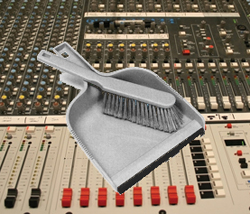Having the luxury of visiting and mixing in many different church sound booths I’ve seen almost everything, from an 8-channel powered mixer sitting (precariously, I might add) on a chair to a fully loaded DiGiCo mixing board/workstation in a 20- by 40-foot decked-out production booth
However, the most indelible impression that sticks with me about each and every booth that I have been in is the organization—or the lack thereof.
Mama always said. “Cleanliness is next to Godliness.’ I don’t want to get into a theological discussion on the issue, but I am going to preach about the importance of keeping your sound booth clean and organized.
Feedback, Buzz & Chaos
I saw it myself. A stressed-out operator was behind the board, the sound check was supposed to be done 15 minutes ago. The service start time was just 10 minutes away. The problem: feedback, buzz, and chaos!
The booth was a whir of activity. The stressed-out operator was yelling things at the tech on the platform such as, “try input 17 on the stage box!” The ttech dutifully stuck his hand In the swirl of mic cables that could be best described as the proverbial rat’s nest. BANG! (Yep, the tech disconnected a live channel.)
Every musician and early arriving parishioner jumped about two feet in the air, one even let out an involuntary “Hallelujah!” The operator—now embarrassed—barked back at the platform, “not that channel’ The other onel”
Needless to say, worship wasn’t necessarily wonderful that day. There are some obvious things that could have prevented this:
1) A pre-planned, written input list
2) Organized stage layout
3) Color-coded cables
4) Labeling the mixing board
In life, and in mixing, a truth that holds is that little things make a big difference. Applying the above listed “little thing”s could have helped set the stage for worship, rather than level it.
Organizational Tools
There are some little things that can be a big help in the sound booth:
— If you have multiple wireless mics, simply put a different colored piece of electrical tape on each system. Using the same color on the transmitter and receiver will allow for a quick visual check of which transmitter goes with which receiver.
— If you have a patch bay, use different color parch cables for input and output connections. If you only have one color patch cable, use colored tape on the connectors. Purchase a patch cable hanger to store the extra cables. You can even use a kitchen towel hanger.
—To store extra connectors there are many plastic storage containers that have multiple compartments for holding things.
—For the various loose cables that inevitably end up in a booth, use a Simple plastic storage unit/file cabinet. This same type or storage works well to hold wireless transrnitters and assorted microphones.
Being organized can make a big difference in the peace you experience during sound check, and always results in a better service—at least from a sonic perspective…
Gary Zandstra is a professional AV systems integrator with Parkway Electric and has been involved with sound at his church for more than 30 years.


















